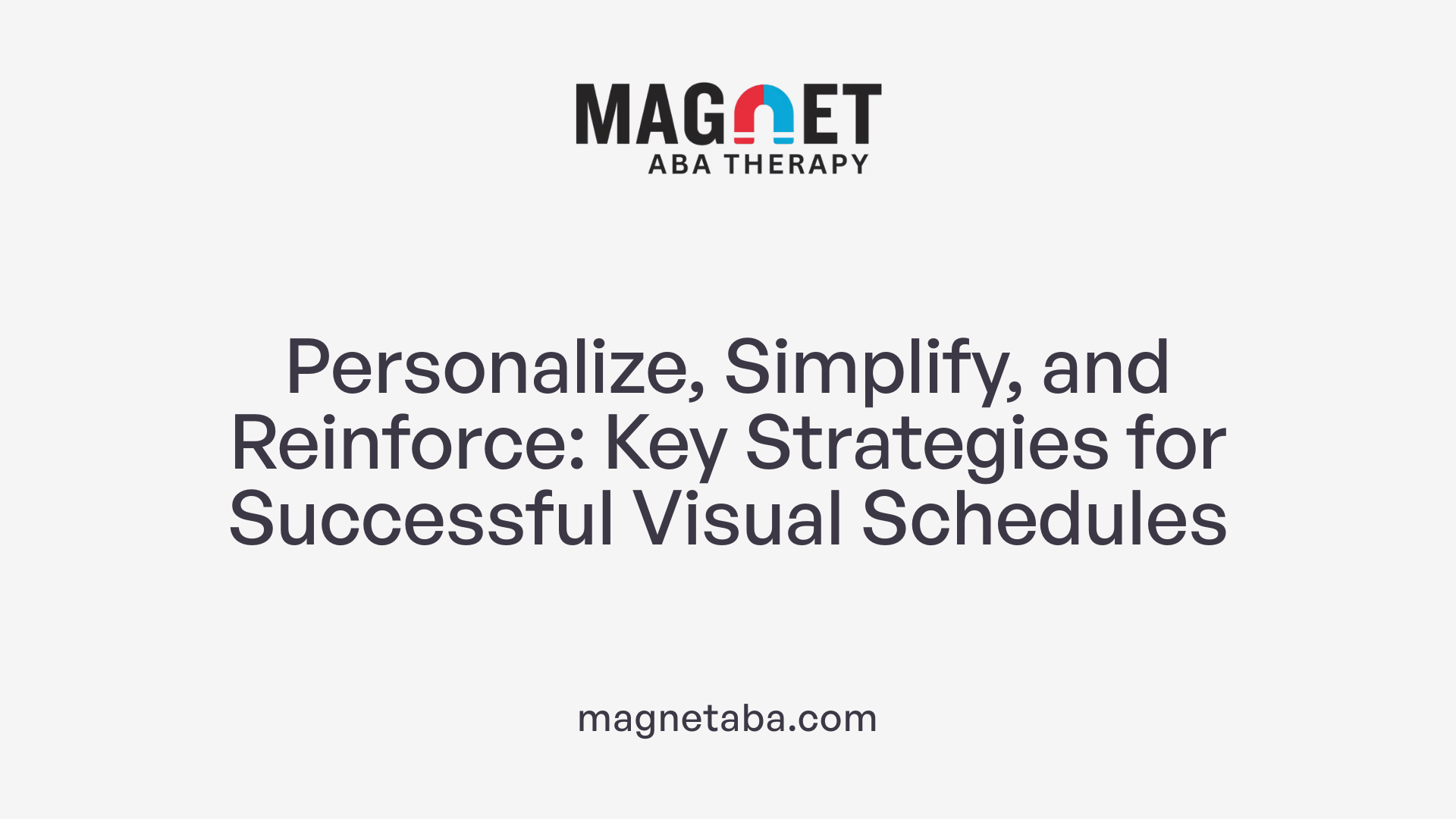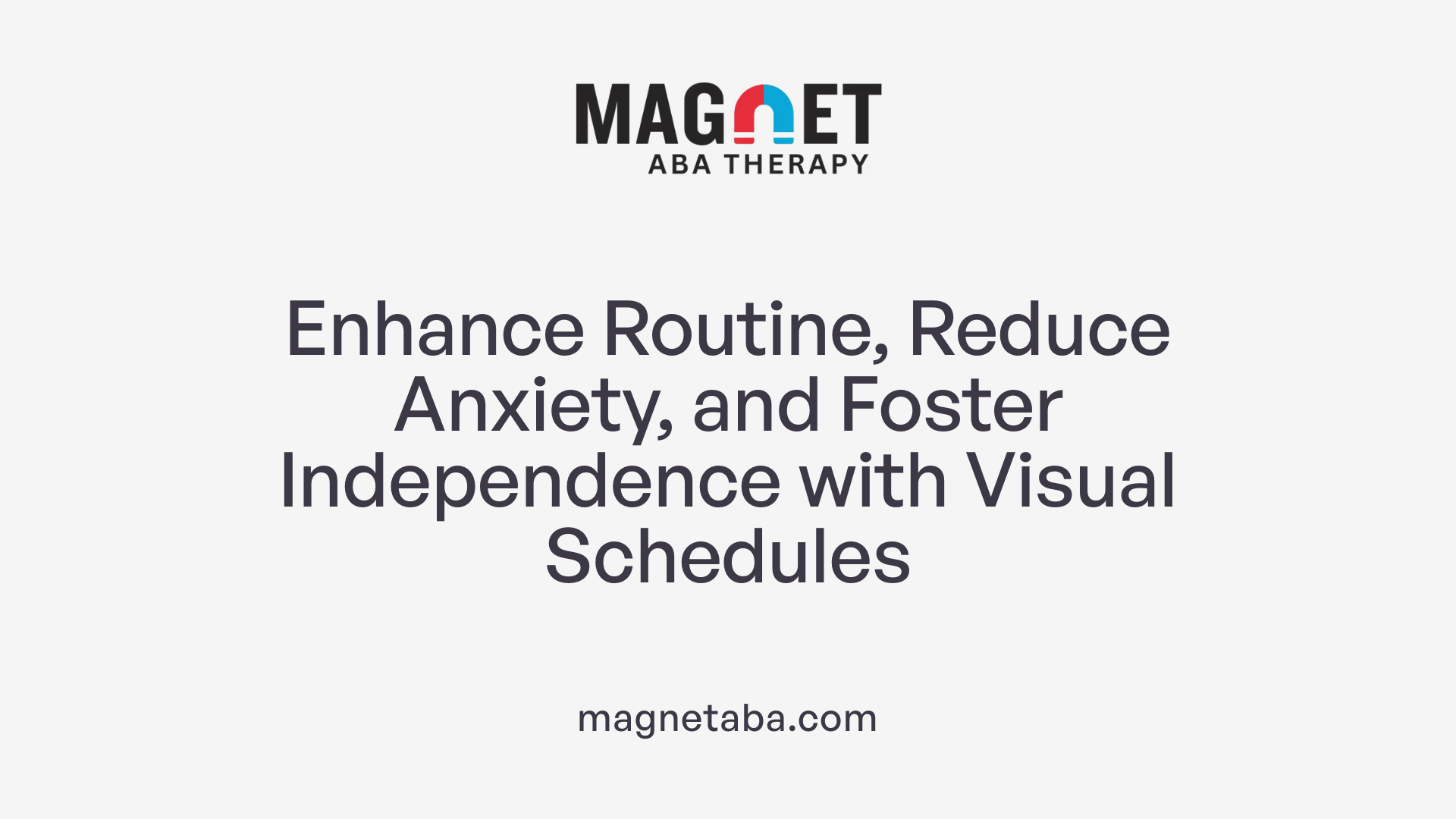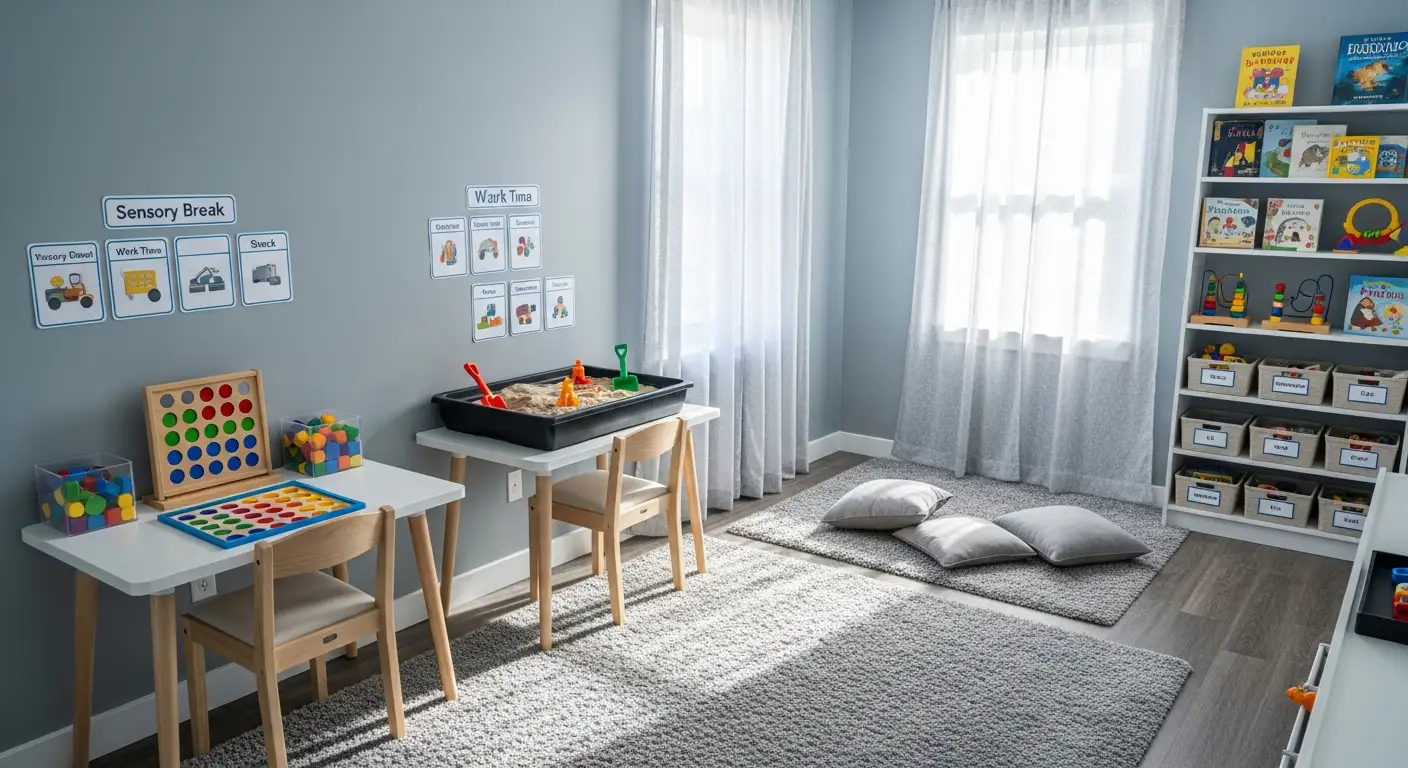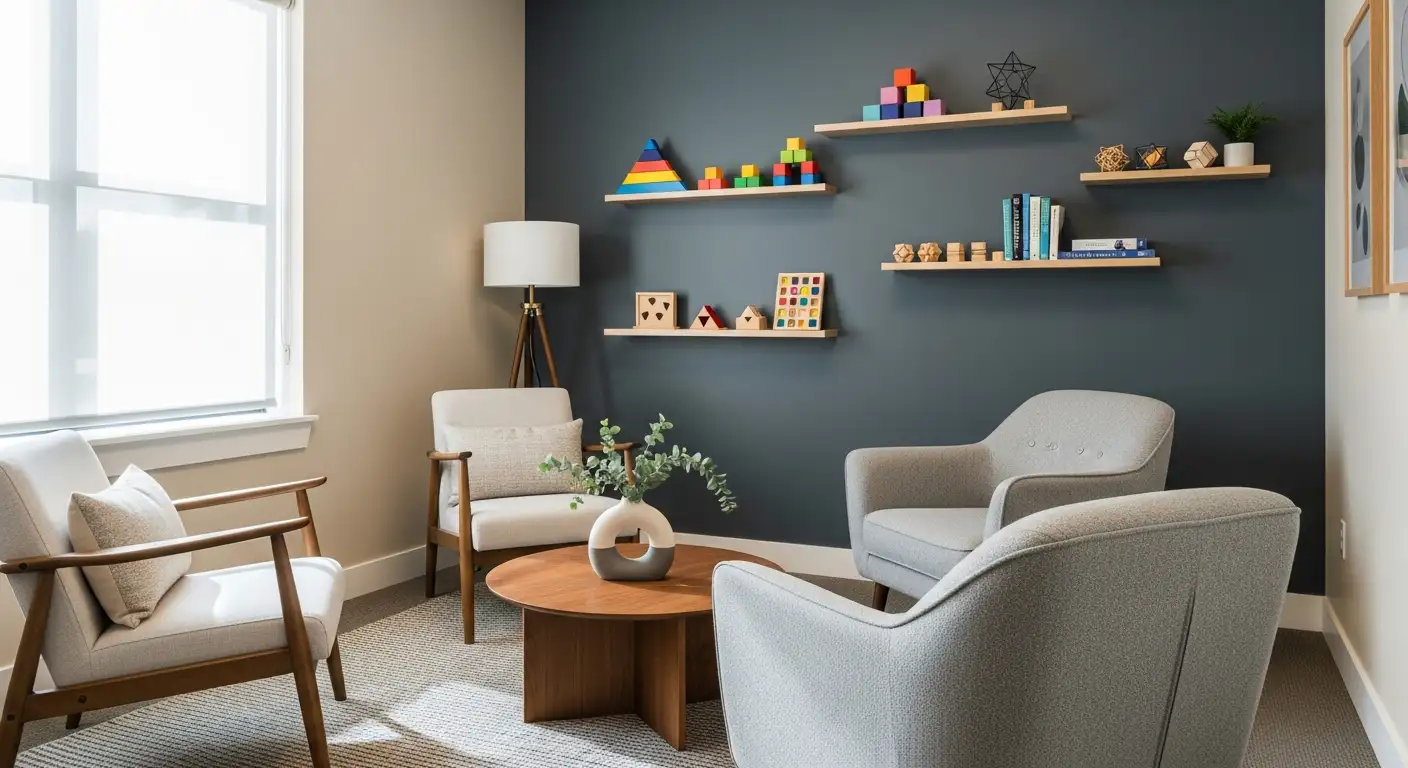Understanding the Power of Visual Schedules in ABA
Visual schedules are a cornerstone in ABA therapy, empowering children with autism and other developmental challenges by providing structured, predictable routines. These tools utilize images, symbols, and words to facilitate understanding, communication, and independence. Implementing them effectively requires strategic planning, customization, and consistent reinforcement, which can significantly reduce anxiety and improve behavioral outcomes.
Best Practices for Implementing Visual Schedules in ABA Therapy

What are best practices for implementing visual schedules in ABA therapy?
Implementing visual schedules in ABA therapy requires careful planning and consideration of the individual child's needs. The first step is to thoroughly assess the child's preferences, abilities, and routines. Knowing what interests the child helps in creating visuals that are engaging and meaningful.
Creating clear and appealing visual supports is essential. These can include pictures, icons, or simple words, arranged in the sequence of daily activities. Consistency is crucial; the visuals should be used across different settings—home, school, or community—to promote familiarity and independence.
Introducing the schedule gradually helps the child become comfortable with the new tool. Use modeling, verbal cues, and physical prompts to demonstrate how the schedule works. Reinforcing successful use through praise or rewards encourages continued engagement.
Regular review and updates of the visual schedule ensure it remains aligned with the child's growth and changing routines. Adjustments might involve adding new activities or modifying visuals as skills develop.
For effective results, involve caregivers and other professionals, maintaining consistency across environments. This collaborative approach supports language development, reduces anxiety, and fosters skills that can be generalized broadly.
In summary, best practices include assessing individual needs, creating engaging visuals, gradual introduction, consistent use, positive reinforcement, and ongoing adjustments to optimize effectiveness.
Strategies for Teaching Children to Use Visual Schedules Effectively

How can visual schedules be used effectively to support children with autism?
Visual schedules are powerful tools that help children with autism understand their daily routines and activities through visual cues such as pictures, icons, or objects. To use them effectively, it is essential to personalize the schedule to match each child's abilities and preferences. This means selecting visuals that resonate with the child's interests and ensuring the schedule reflects their typical daily sequence.
Starting with simple, manageable schedules—containing only 2-3 activities—is recommended. This prevents overwhelming the child and allows them to gain confidence in using the schedule. As they become more comfortable, the schedule can be gradually expanded with more activities and complexity.
Explicit teaching methods are vital for introducing and explaining the schedule. Demonstrating how to follow the visuals step-by-step, role-playing, or using prompts helps reinforce understanding. Encouraging active participation—such as letting the child place pictures or check off completed tasks—fosters engagement and independence.
Reinforcement plays a significant role in motivating children to follow their schedule. Praising their efforts, offering small rewards, or providing positive feedback when they complete activities encourages continued use. Over time, prompts and assistance should be gradually faded, encouraging the child to rely more on the schedule and less on prompts.
Involving caregivers—parents, teachers, or therapists—is crucial for consistent implementation across settings. Teaching them how to introduce, review, and adapt the schedule ensures the child receives continuous support, promoting routine and skill transfer.
By incorporating these strategies, visual schedules can become an effective aid to improve understanding, reduce anxiety, and foster independence in children with autism.
Step-by-Step Guide to Creating and Using Visual Schedules in ABA

What is a step-by-step guide to creating and using visual schedules in ABA therapy?
Creating and using visual schedules in ABA therapy involves a thoughtful series of steps designed to support children’s independence and understanding of routines. The process begins with understanding the child's unique needs and abilities. Observing the child helps determine how they process visual information and what types of visuals—pictures, icons, or words—are most effective.
Next, select the appropriate visuals that resonate with the child’s preferences and are easy to recognize. These visuals should clearly represent each activity or task in a way that the child can interpret independently. Gathering materials such as photographs of the child performing activities, simple drawings, or printed icons is essential.
Organize the activities in a logical, chronological order, creating a sequence that reflects the day’s routine. Start with simple schedules that include just 2-3 activities to prevent overwhelm. Use clear and concise visuals for each step, and consider including visual cues like checkboxes or velcro for interaction.
Introducing the schedule should be gradual. Explain each activity using simple language, and encourage the child's participation by guiding them to follow along. Consistent reference to the visual schedule throughout the day helps reinforce understanding and routine compliance.
Reinforcement plays a vital role. Praise the child when they follow the schedule correctly, and provide rewards that motivate continued engagement. This positive feedback boosts confidence and motivation.
Finally, regularly review and adapt the schedule as needed. As the child masters routines, increase the complexity or add new activities. Be flexible enough to accommodate spontaneous changes or surprises, using symbols like a question mark to alert the child to potential disruptions.
Through these structured steps—understanding individual needs, selecting appropriate visuals, organizing tasks, gradual introduction, reinforcement, and continuous adaptation—visual schedules become a powerful tool in ABA therapy, helping children develop independence, reduce anxiety, and improve communication.
Benefits of Using Visual Schedules in ABA Therapy

What are the benefits of using visual schedules in ABA therapy?
Visual schedules are powerful tools in ABA (Applied Behavior Analysis) therapy. They are graphic representations of routines, using pictures, symbols, or words to show the sequence of activities or tasks. These schedules serve as a 'roadmap' for children, helping them understand what to expect during different parts of their day.
One of the primary advantages of visual schedules is that they promote predictability and routine. When children see a clear sequence of activities, they gain a sense of stability, which can significantly reduce feelings of uncertainty and anxiety. This predictability helps children feel more secure and prepared for transitions, minimizing stress and challenging behaviors.
Visual schedules support communication and understanding, especially for children with autism, speech delays, or sensory processing difficulties. They provide visual cues that complement spoken instructions, making it easier for children to comprehend what is expected. For visual learners, this approach enhances engagement and helps develop language skills.
Furthermore, visual schedules foster independence. When children can follow the sequence of tasks on their own, they learn to manage their activities with less direct prompting from caregivers or teachers. This promotes confidence and motivates children to participate actively in daily routines.
Using these schedules also makes transitions between activities smoother and less stressful. For example, a visual prompt can prepare a child for upcoming changes, reducing resistance and meltdowns.
Research supports their effectiveness, showing that visual supports, including schedules, significantly decrease challenging behaviors and increase how much children engage with tasks. This evidence-based practice enhances learning, organization, and behavioral stability.
Overall, incorporating visual schedules into ABA therapy helps children navigate daily routines confidently, reduces anxiety, and promotes greater independence, all while supporting better communication and behavioral outcomes.
Why Visual Supports Are Vital for Children with Autism
How do visual supports aid children with autism, and why are they important?
Visual supports are essential tools that help children with autism understand and navigate their daily routines and social interactions. They provide clear pictures, symbols, or written cues that illustrate what is expected, helping children process information more easily.
Children with autism often have strong visual processing skills. By tapping into this strength, visual supports make instructions, routines, and social cues more accessible. This reduces confusion and frustration that can happen when information is delivered solely through spoken language.
Examples of these supports include visual schedules that outline daily activities, choice boards that assist in decision-making, and social stories that prepare children for social situations. These tools help children anticipate what comes next, manage transitions, and build independence.
Using visual supports reduces uncertainty, which is often a source of anxiety and challenging behaviors in children with autism. When children know what to expect, they feel more secure and confident.
Moreover, visual supports foster communication and social understanding by providing visual cues that complement speech. This encourages participation in routines, supports learning, and enhances social skills.
In various settings—be it at home, in school, or out in the community—visual supports serve as a consistent, helpful framework. They boost children’s independence, boost their confidence, and improve their overall ability to engage and participate actively.
Research from 2019 highlights that implementing visual supports significantly reduces challenging behaviors and increases task engagement in children with autism, underlining their crucial role in positive development.
Examples and Templates for Visual Schedules in ABA

What are different formats of visual schedules used in ABA therapy?
Visual schedules come in various formats to meet individual needs. They include picture-based schedules using simple icons or photographs, as well as written cues for children who identify with reading. Some schedules combine both visuals and text, offering a multi-sensory approach. Portable versions, like laminated cards and binders, allow children to carry their schedules easily, while wall-mounted schedules provide continuous visual support.
Can you provide examples of visual schedules and templates for ABA therapy?
There are numerous templates designed for different settings and activities. Common examples include:
- Daily routine charts for mornings, afternoons, and evenings.
- School schedule templates highlighting subjects, breaks, and activities.
- Social event planners for outings or parties.
- Activity sequence charts breaking down multi-step tasks.
Many of these templates are available as free printable resources online, allowing customization with preferred visuals or photos of the child.
How do visual symbols enhance understanding?
Visual symbols like icons for food, play, hygiene, or specific activities help children recognize and anticipate what comes next. Using visuals aligned with the child’s interests makes schedules more engaging. Tools such as first-then boards or activity sequence charts organize daily tasks and foster independence by clearly showing what happens first and what follows.
How do these tools promote independence and reduce anxiety?
Visual schedules provide predictability, helping children feel more in control of their day. By understanding what to expect, children experience less anxiety and fewer meltdowns. Reinforcing success with praise or rewards encourages continued use and skill development. Regular review and adaptation of schedules ensure they stay relevant and effective.
Resources and customization options
Many websites offer printable visual schedule templates that can be personalized with images or text suited to the child's preferences. These resources help caregivers and educators craft schedules that are manageable and engaging, supporting children’s growth toward greater independence and confidence in routine tasks.
Empowering Through Visual Supports
Incorporating well-designed visual schedules into ABA therapy can transform routines for children with autism, fostering independence, reducing stress, and enhancing learning. By understanding the principles of effective implementation—assessment, customization, gradual introduction, reinforcement, and review—practitioners and caregivers can optimize outcomes. The versatility of visual supports, including pictures, symbols, and digital tools, makes them adaptable to various settings and individual needs. As research continues to highlight their benefits, the strategic use of visual schedules remains a vital and evidence-based practice. When used effectively, these tools truly serve as a roadmap, guiding children toward greater independence and success.
References
- Why & How to Use Visual Schedules - TherapyWorks
- How to Teach Students to Use Visual Schedules - How to ABA
- A Practical Guide to Creating Visual Schedules
- The Visual Schedule for Students With Autism
- How to Create Visual Schedules for Children with Autism | Childwise
- Visual Supports » Center for Autism and Related Disabilities »
- Visual Supports for Autism: What are the Benefits?
- ATN/AIR-P Visual Supports and Autism
- Visual supports at home and in the community for individuals with ...












